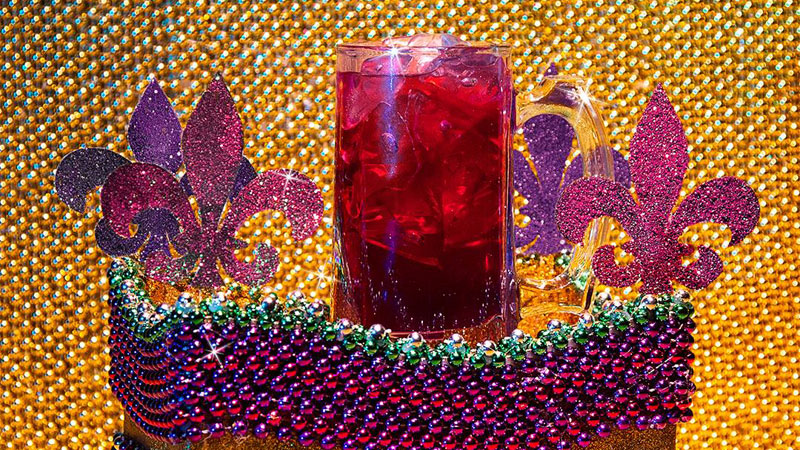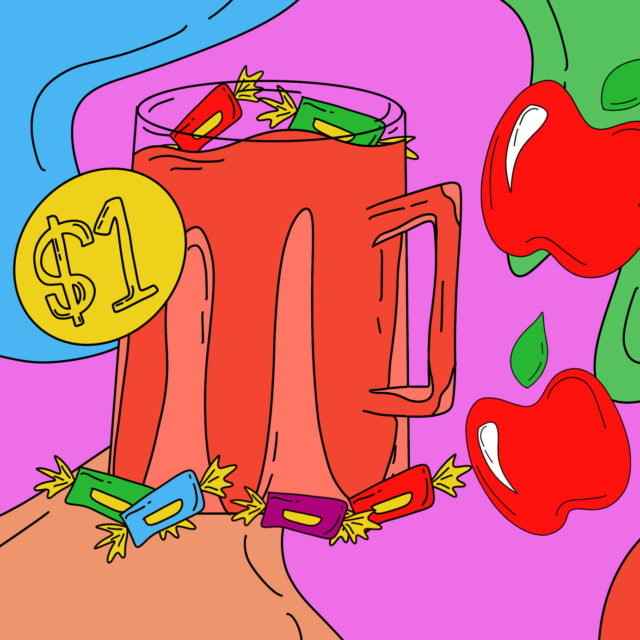
Applebee’s knows us better than we know ourselves. In 2018, the fast-casual company successfully reinvigorated its brand by ditching menu items customers “can’t pronounce,” and doubling down on “comfort.”
It worked. As Chipotle shuttered 65 chain locations, and vegan darling byChloe splintered, Applebee’s emerged victorious. Weekly same-stores sales were up 7.7 percent toward the end of 2018, according to a brand executive’s estimate.
The ever-elusive “millennial” market was especially supportive of Applebee’s rebrand and its series of $1 and $2 cocktail specials. Despite our supposed fixation on high-end artisanal products, millennials couldn’t resist the siren song of kitschy drinks like $1 Strawberry Margaritas or Dollar Jollys, a holiday special made with vodka and either cherry or green apple Jolly Ranchers.
While it would be easy to write off the depressed economy as the primary driver of these cheap drinks’ popularity, is there something else going on here? What if people actually like this booze because it’s, well, bad?
The subtleties of ironic consumption, decried by “new sincerity” writers like David Foster Wallace, are nuanced. Self-serious beer, wine, and cocktail enthusiasts might scoff at certain trends, but their taste is just as subjective as anyone else’s. Besides, who gets to decide who is a “tastemaker” and who’s just tacky?
The revaluation of “bad” aesthetics is deeply tied to the concept of “camp,” which existed long before cultural critic Susan Sontag defined it in a seminal 1964 essay. Sontag describes a certain sensibility, primarily but not exclusively belonging to homosexuals, in which a work of art could be appreciated outside the realm of perceptions of goodness or badness. Camp celebrates the artificial, the overdone, the spectacular failures of culture.
“[Camp] doesn’t argue that the good is bad, or the bad is good. What it does is to offer for art (and life) a different — a supplementary — set of standards,” writes Sontag.
Or, put more succinctly: “It’s camp: the tragically ludicrous or the ludicrously tragic!” explains a character played by legendary filmmaker John Waters in an episode of “The Simpsons.”
You can spot the impact of camp everywhere from horror movies to the Met Gala. Is it possible our national esteem for trashy drinks is part of this same, tragically ludicrous sensibility?

The decor of the Applebee’s in Astoria, New York suggests otherwise. Almost utilitarian in its plainness, the Queens restaurant did not list the headline-driving cocktail special (a $2 Rum and Coke), on its menu the night I visited. When I asked a perfectly affable waitress about it, she excitedly confirmed the drink’s existence. What arrived was a decidedly watered down Rum and Coke that contained about 80 percent ice and, confusingly, Pepsi. It tasted more like nothing than anything at all.
My second drink there, an $11 Long Island Iced Tea (easily the location’s most popular cocktail, said the same waitress) arrived in an oversized glass goblet. And although it tasted like cleaning solution, I can confirm that I was sufficiently sloshed by the time I’d finished.
The feeling I got from this visit to Applebee’s was far from the exquisite pleasures in Sontag’s camp canon, such as “stag movies seen without lust” or the ballet “Swan Lake.” The restaurant was filled with a diverse array of families and couples having a totally pleasant evening meal, but there was something deeply banal, almost dystopian about the scene. There were touchscreens on every table, through which you could order Disney movies and video games to watch and play while you ate.
On the other hand, there was also something freeing about the experience. Its unapologetic banality gave us, the participants, license to abandon our expectations of “quality.” We didn’t need to worry about the caliber of our cocktails or implications of family meals beset with screens. We could simply embrace the absurdity (and, perhaps, tragedy?) of the endeavor.
Jay McInnes, an independent critic who runs The Scrappy Progressive, a beer blog that self-deprecatingly identifies as “really pompous,” had trouble conceptualizing Applebee’s as “camp.” Applebee’s does appeal to people, McInnes says, but on two other tracts.
On the one hand, McInnes says, “It’s a place where people go to drink … It has mass appeal. There are a lot of 40-, 50-, 60-year-old parents who want a simple drink and have low expectations. That’s a good night out! People want cheap, sweet, liquor. It’s there.”
For a smaller subset of economically advantaged or intellectually-minded millennials, a trip to Applebee’s offers potable irony, and a snobby disdain for mainstream culture. For these patrons, drinking at Applebee’s is devoid of the “tender feeling” described by Sontag and essential to camp.
“There’s a kind of rejection of normcore as a culture but a simultaneous celebration of how transgressive it is. I don’t understand it, but it’s there — and it makes money,” McInnes says. “If you cloak it in irony, you can get away with going to one of these places because you just know what a chain delivers to you: a consistent product presented with a clean and friendly face.”
“It’s something rich college kids would do,” McInnes says. “‘Hey, look at these poor people, let’s go to Applebees like they do.’ It’s saying, ‘How can I min/max my consumption while at the same time getting a story about it.’ Later, with your friends, at the $15 cocktail place, you can say, ‘We were at Applebees having this really normie drink, but this re-conceptualization of a Margarita is really much better.’”
Daniel Ng, a sommelier at O Ya in New York City, has a different, and less cynical read on Applebee’s success.
“I think what people enjoy about fine wine or craft beers is that they’re usually really complex and have a lot of different nuances. And that’s great,” Ng says. “But I think there’s a time and place for everything. Sometimes you don’t want a really hoppy beer to pair with your food, sometimes you want something that’s really crushable, that you don’t have to think about.
“What is enjoyable about Applebee’s drinks is that people don’t really have to ruminate about them. It’s simple. They have a lot of sugar, and people love sugar. And there’s nothing wrong with liking sweet things.”
Ng believes nostalgia is the primary motivator for those ironically drinking good in the neighborhood.
“For some of my friends who grew up in the suburbs, Applebee’s was a big part of their childhood,” Ng says. “It was a place you would go to with your friends in high school. It was maybe the first restaurant you went to without your parents.”
If Applebee’s owes its success to nostalgics, value-seekers, and ironical snobs, where does that leave camp? Is there no place for camp in the bar world?
Behold, the colorful exuberance of tiki.
Rob Nitschke, a DJ at tropical New York City institution Otto’s Shrunken Head, says bright decor and sweet, boozy drinks are essential to tiki’s allure. “The culture is great too: When it’s actually being done right, it’s some level of over-the-top,” Nitschke says. “If you’re calling yourself a tiki bar, you’re not going to look like some average pub. There should be a water feature, blowfish lights, pictures of hula girls, color. It should be fun to sit in the room.”
“Everything was pose and performance,” Vogue’s Hamish Bowles wrote of camp culture in Louis XIV-era Versailles. He could just as well have been describing tiki bars.
Tiki has been the subject of well-deserved cultural criticism, but a thoughtfully conceived tiki bar provides much-needed escapism. “Historically, tiki was an outlet for people that didn’t let loose otherwise,” Nitschke says. In the buttoned-up 1950s, being served a drink by “a girl in a coconut bikini” felt racy and subversive.
Today, some critics regard the resurgence of tiki culture as a reaction to socioeconomic anxiety and neo-conservatism in the Trump era. Of course, that hardly qualifies as camp, either.
In his book “Shock Value,” Waters reminds readers that “there is such a thing as good bad taste and bad bad taste.” Watered-down Applebee’s cocktails would likely qualify as the latter; but, then again, like all things, good Pepsi is in the eye of the beholder.
